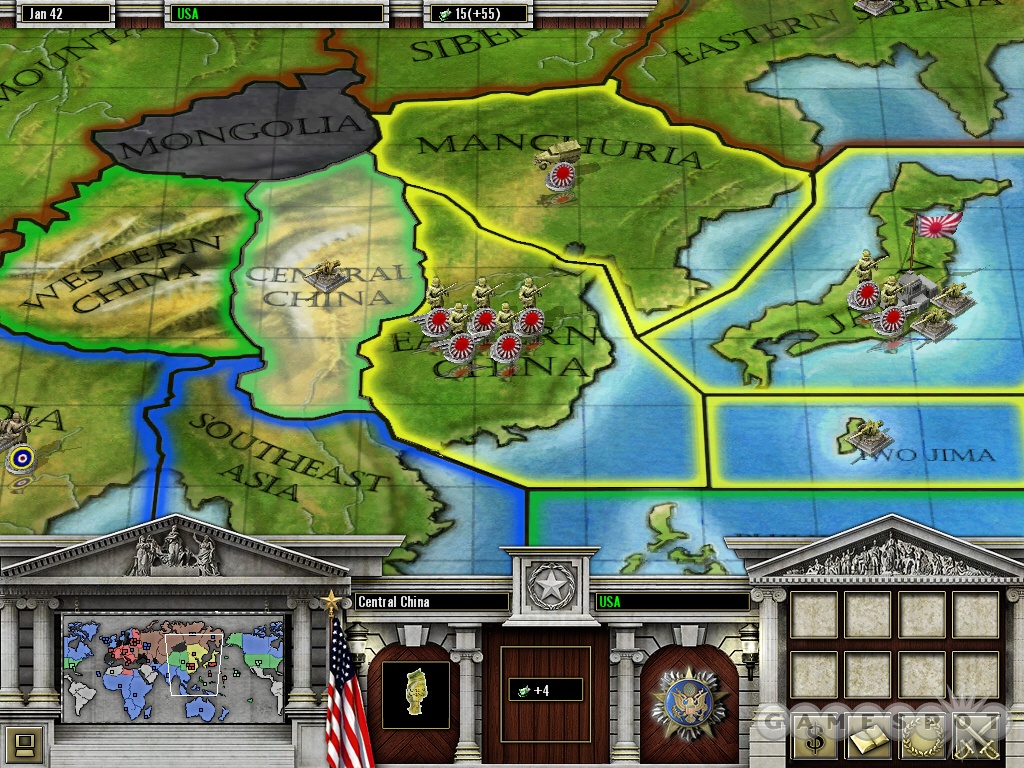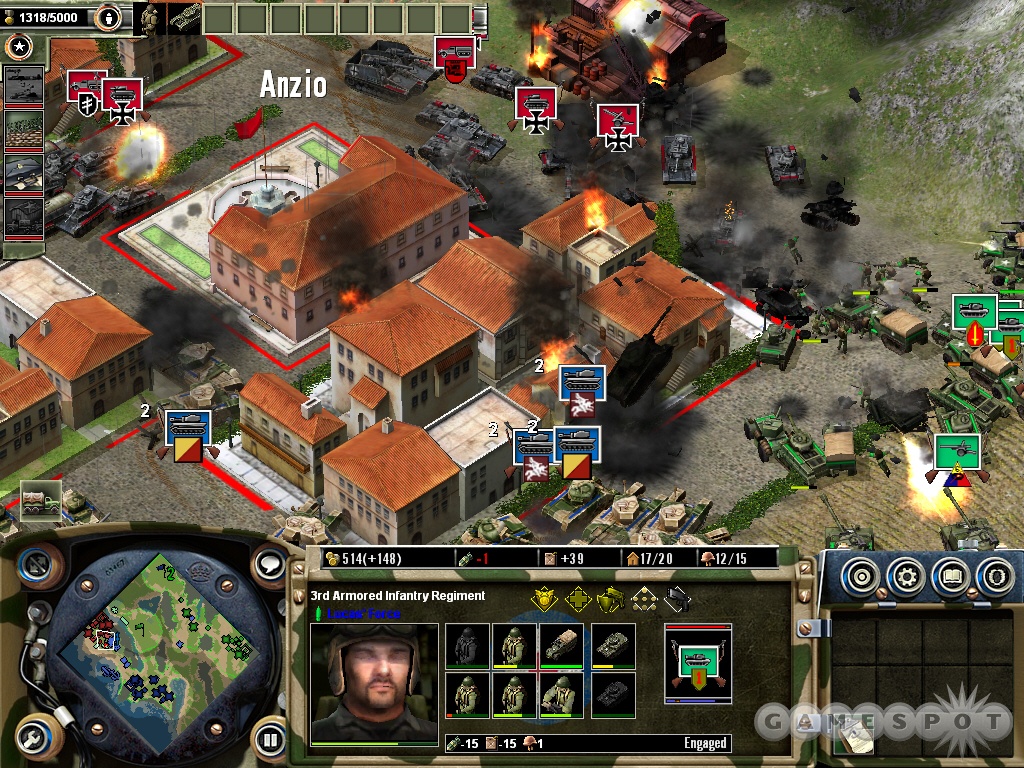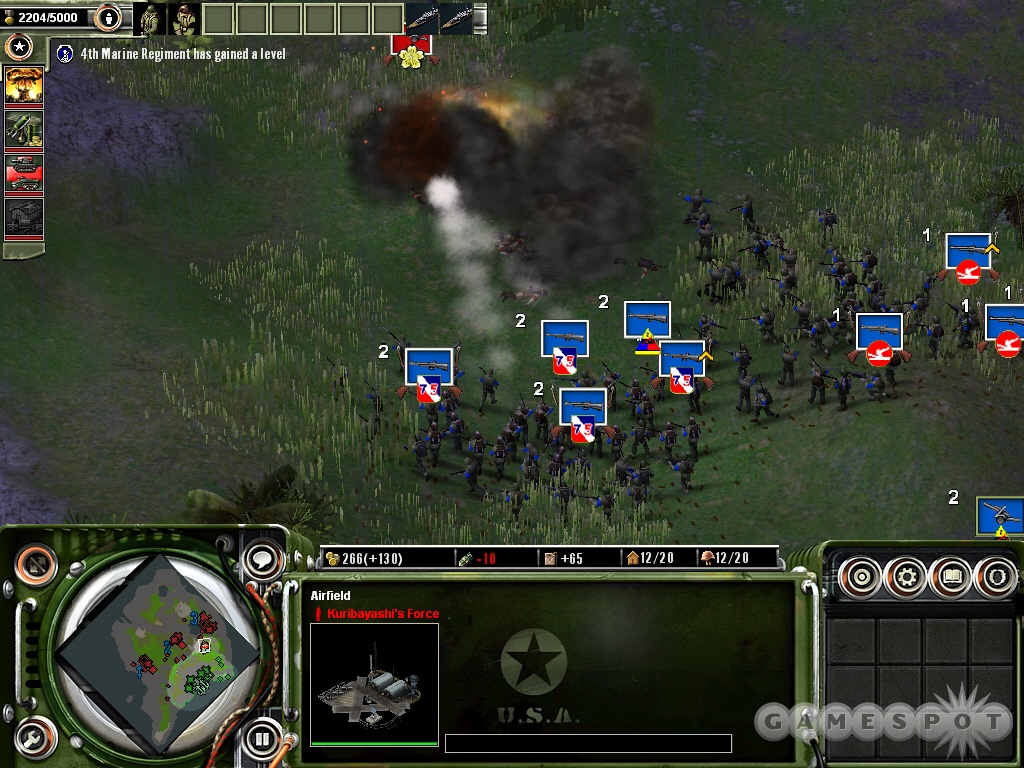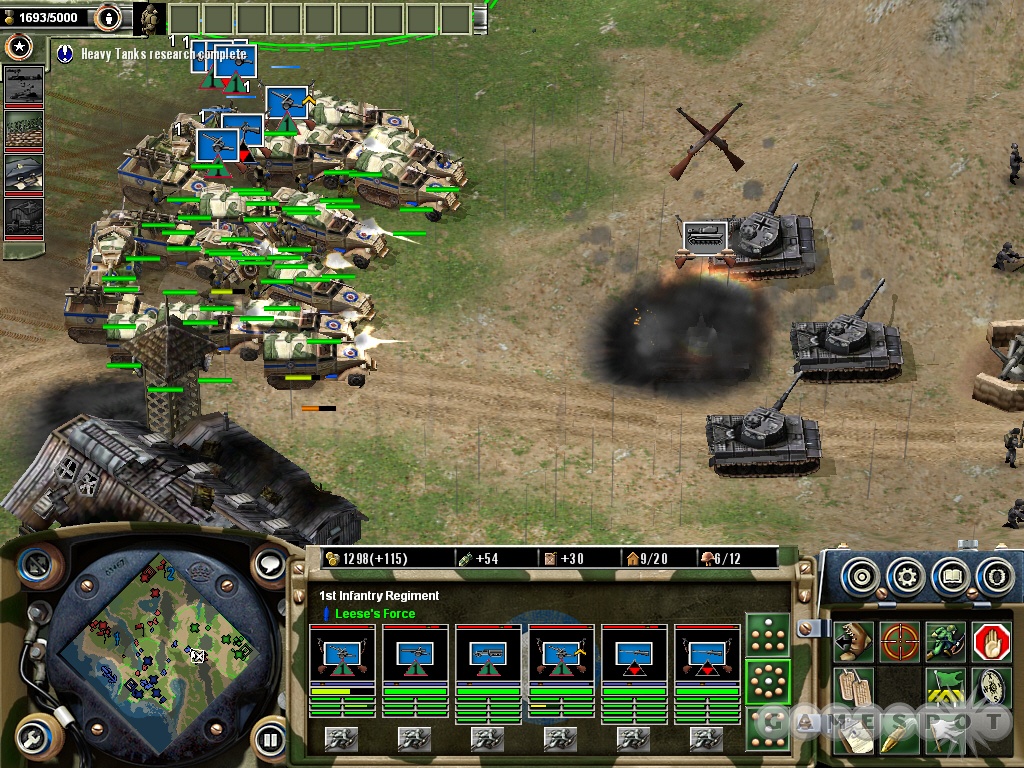In addition to being a new real-time strategy game, Axis & Allies is a cult classic board game that pits the Axis powers against the Allied powers at the height of World War II. The new computer game is not the game of old, however. Developer TimeGate Studios, which recently produced the great Kohan II: Kings of War, has put a different spin on the concept so that battles are resolved in real-time skirmishes rather than with rolls of dice. Unfortunately, this different spin doesn't equate to a refreshing change. Incompetent artificial intelligence and some weak gameplay mechanics hamper what could have been an interesting take on the popular board game.

Axis & Allies uses the Kohan II engine, so it plays very similarly to the fantasy strategy game released a little more than a month ago. You don't harvest resources in Axis & Allies; instead, you have a constant income of money, ammo, and oil. Ammo and oil are not hoarded. Rather, you have a positive or negative flow of these resources. You gain an increased rate of income by building ammo and oil depots, while a negative inflow of these two resources penalizes your money income. Meanwhile, money accumulates if you have a positive income, and you'll use this money to construct buildings, research technologies, and build military units. When you have no money and a negative income, then your units will begin to lose health until you overcome the deficit. All this actually makes it worthwhile to strike at your opponent's resource buildings to simultaneously cripple his or her economy and army.
Your military is also handled similarly to Kohan II. Instead of recruiting individual units, you'll recruit companies. Companies comprise squads of multiple units that act as single units. Injured companies are replenished automatically in supply zones generated by both your buildings and cities. As in Kohan II, this helps minimize the need for micromanaging a bunch of little infantrymen, tanks, and other units. In Axis & Allies, a company must be attached to a headquarters to be supplied. So if you build three armor companies from an infantry headquarters, those units will be supplied as long as the headquarters survives.
There are four modes of play in Axis & Allies: World War II, campaign, skirmish, and multiplayer over LAN or Internet. World War II mode is the one that's most similar to the board game. You pick one of the five world powers (Great Britain, Germany, Russia, Japan, or the USA) and then choose a general for that faction. This turn-based mode is played on a world map divided into territories that are each worth a given amount of income. You'll use cash on your turn to research technologies and purchase armies, which are used to attack and capture territories under enemy control. The goal of both the Axis and the Allies is to capture two opposing capitals.
This is where the similarities to the board game end. Your three army types--infantry, mechanized, and armor--can only move one space (there are no mechanized units in the board game, and armor could move two spaces). There are no naval or air units, and you can't build factories, so moving new armies from your capital one space at a time can be tedious. The most interesting and potentially fun aspect of this mode is how conflicts are resolved. Instead of rolling dice, you can fight battles in the RTS mode. Armies on the map determine which types of buildings you can make in the RTS mode and how much money you start with. For example, a mechanized army means you can build infantry and mechanized units in the battle, but you can't build armor units. Unfortunately, the potential for fun is lost, because the computer AI simply isn't very good. So if you're a reasonably experienced RTS player, you'll be able to pull off victories even against overwhelming odds. You can also have the computer automatically resolve conflicts, but that's a simulation of bad AI versus bad AI, so you probably won't like the results...unless the odds are heavily in your favor.

The strategic AI on the world map isn't very bright either. It will spend too much money on technologies early on rather than spending this money on armies. As the US, we were able to push back Japan with only infantry, yet Japan spent its money on antitank technology rather than recruiting armies to stop us. The AI also can't comprehend that you can pull off miracle victories (thanks to the stupidity of the AI in RTS battles). It would continue attempting to take our territories (calculating, say, that it had an 86 percent chance to win), even though we'd just keep repelling the AI's attack every turn. There are also fundamental flaws in how the map is set up, such as how Germany is able to take Russia's capital in two turns with ease. You can beat the World War II mode in only a few hours, even with multiple RTS battles. The flawed AI and broken map make this mode a disappointment.
The two campaigns in Axis & Allies follow each side's road to victory. The Allied campaign features some of the most well-known battles in World War II, including Kursk, D-Day, and Iwo Jima. The Axis campaign is more of a what-if scenario. For example, when you defeat Montgomery at El Alamein, Rommel takes the Suez Canal and meets with German forces at Stalingrad. There isn't much cohesion between missions. In fact, the ordering of the missions is confusing, at first. The Allied campaign starts with a cutscene in Russia, yet the first and second missions take place in El Alamein and Guadalcanal, respectively, without any sort of bridge to connect the missions. Only those knowledgeable in WWII history will realize that the missions take place chronologically, since nowhere in the campaign are you given any actual context for when they take place. The hodgepodge assortment of missions doesn't do much to make you care for any particular side, faction, unit, or leader. And, as mentioned, the artificial intelligence isn't going to put up much of a fight.
In all three modes in which you battle the computer AI, you'll probably be severely disappointed at how poorly it plays the game. The computer does a good job of directing its forces to attack different locations, but when it comes down to strategy, the computer fails miserably. You can tell that it has rigid build orders and attack priorities. For example, you can have a single infantry group attack an enemy base from one direction. This draws the entire defending force to attack that one group, even if the defending force had just been fighting a huge force on the other side of its base not too long ago. The computer should know that you have a massive force ready to pounce, yet it leaves you to demolish its base. As a result, matches don't even have to last that long. In the World War II battles and skirmishes, you can rush the enemy with a handful of infantry and come away with a victory pretty much every time, because the computer doesn't build defenses right away.

Rushing with infantry is how you can get miracle victories against the odds, and doing so also exposes a fundamental weakness in the game's build order. To construct mechanized and armor buildings, you have to erect an infantry building. Before you can produce engineers that construct defensive structures, though, you have to fabricate an infantry building and an engineer brigade. While you're saving up money to construct these buildings, the opponent can buy cheap infantry and attack you before you can even have units...unless you choose the same strategy. There has always been a decision to be made as to whether to rush early (militarily) or move up the technology tree in real-time strategy games, but Axis & Allies has made this decision a no-brainer: You have to build infantry. Not only can you attack and defend your base in the beginning of the game with infantry, but also you can use them to capture cities to increase your income. Again, the problem is that the computer doesn't actually do this. It will slowly produce a couple of infantry units before saving up to build a mechanized building, thus leaving itself wide open to attack.
There are other times when the AI is downright sloppy. The most glaring glitch occurs when capturing cities. Basically, if two opposing forces are in a town's vicinity, then the town is contested. If a town is under your possession and you have a unit in the vicinity, the computer's unit will often just sit in the center of town instead of flushing you out. The result is that the city will remain contested indefinitely. Also, you can bombard enemy positions with artillery, and oftentimes the enemy will sit there and do nothing. You can even build defensive bunkers in the enemy's line of sight, just outside of firing range, and the enemy won't try to stop you. You can then lure the enemy units into the bunker's firing range and decimate the force.
There just isn't much strategy in the single-player portion of Axis & Allies, even without these AI problems. Since companies get resupplied quickly, it's hard to overcome an opposing computer army if you're evenly matched. The computer is able to manage its forces so they effectively survive to receive healing. Therefore, you usually want a vastly superior force. As a result, the game boils down to sheer numbers. Attack with more guys than the computer and you win. It doesn't matter if you have infantry or tanks. As long as you swarm the enemy, you can win. In fact, you can plow through anything with 20 antitank infantry (20 is the maximum unit count). As mentioned before, the computer can't come up with a counter to mass infantry.
There really isn't much of a counter to it anyway, beyond spamming 20 infantry of your own. Getting enough vehicles to fight 20 infantry would be very expensive, and it would take a long time. Bombers can do some damage, but, again, airfields are far down the tech tree, and bombing runs cost money. Infantry are cheap and fast to build, and they're very effective. It's disappointing that the game essentially discourages the use of diverse fighting forces.
In a nod to Command & Conquer: Generals, your general has four powers that you can use throughout a match--once you've collected enough experience. Each general has different powers, although each general does have "corps reorganization," which summons a new corps HQ when his is destroyed. Powers range from temporary economic bonuses to the devastating atom bomb. The area-of-effect powers tend to be more useful, because your units will naturally tend to clump together. The atom bomb can completely wipe out most companies in its blast, clearing the path for your armies to advance. The game attempts to balance this by making it the most expensive ability, but one clear path is all you need to decimate a base in this game.
Multiplayer can be a better gaming experience, because human players will be more adept at countering the various strategies that can easily overcome the AI. Humans can plan ambushes, trap fleeing units, and effectively use general powers. You can pick between random maps and custom scenarios in both multiplayer and skirmish modes. Expect multiplayer games to last much longer than single-player skirmishes when facing opponents of equal skill. The Internet in-game browser is adequate, and it lists both available games to join and players who are online.

Axis & Allies isn't the greatest game to look at. The graphics are acceptable, but there isn't much to please the eye. Buildings look similar, even across the various nations. Infantry and vehicle models aren't very distinguishable or detailed, either. Explosions don't pack much of a visual punch. Only nuclear explosions look devastating, yet they still seem weak because of the game's rather bland audio. The music fits well, but the various accents you'll hear as part of the voice acting seem forced and fake.
While the game's multiplayer portion can be enjoyable, it's hard to recommend Axis & Allies based on that aspect alone, especially since the real-time strategy genre is filled with so many excellent, well-rounded games. The single-player portions of the game are ridiculously easy, even on the hard settings. Only a few campaign missions are remotely challenging, and even these cases are due to poor AI with Allied forces. Simply put, there are much better World War II games on the market, and Axis & Allies board game fans are encouraged to steer clear.